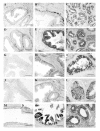Role of IAPs in prostate cancer progression: immunohistochemical study in normal and pathological (benign hyperplastic, prostatic intraepithelial neoplasia and cancer) human prostate
- PMID: 20078866
- PMCID: PMC2838819
- DOI: 10.1186/1471-2407-10-18
Role of IAPs in prostate cancer progression: immunohistochemical study in normal and pathological (benign hyperplastic, prostatic intraepithelial neoplasia and cancer) human prostate
Abstract
Background: In this study was investigate IAPs in normal human prostate (NP), benign prostatic hyperplasia (BPH), prostatic intraepithelial neoplasia (PIN) and prostatic carcinoma (PC), and their involvement in apoptosis/proliferation via NF-kB (TNF-alpha, IL-1) stimulation.
Methods: Immunohistochemical and Western blot analyses were performed in 10 samples of normal prostates, 35 samples of BPH, 27 samples diagnosis of PIN (with low-grade PIN or high-grade PIN) and 95 samples of PC (with low, medium or high Gleason grades).
Results: In NP, cytoplasm of epithelial cells were positive to c-IAP1/2 (80% of samples), c-IAP-2 (60%), ILP (20%), XIAP (20%); negative to NAIP and survivin. In BPH, epithelial cells were immunostained to c-IAP1/2 (57.57%), c-IAP-2 (57.57%), ILP (66.6%), NAIP (60.6%), XIAP (27.27%), survivin (9.1%). Whereas low-grade PIN showed intermediate results between NP and BPH; results in high-grade PIN were similar to those found in PC. In PC, epithelial cells were immunostained to c-IAP1/2, c-IAP-2, ILP, NAIP, XIAP (no Gleason variation) and survivin (increasing with Gleason).
Conclusions: IAPs could be involved in prostate disorder (BPH, PIN and PC) development since might be provoke inhibition of apoptosis and subsequently cell proliferation. At the same time, different transduction pathway such as IL-1/NIK/NF-kB or TNF/NF-kB (NIK or p38) also promotes proliferation. Inhibitions of IAPs, IL-1alpha and TNFalpha might be a possible target for PC treatment since IAPs are the proteins that inhibited apoptosis (favour proliferation) and IL-1alpha and TNFalpha would affect all the transduction pathway involucrate in the activation of transcription factors related to survival or proliferation (NF-kB, Elk-1 or ATF-2).
Figures


Similar articles
-
TNF/IL-1/NIK/NF-kappa B transduction pathway: a comparative study in normal and pathological human prostate (benign hyperplasia and carcinoma).Histopathology. 2008 Aug;53(2):166-76. doi: 10.1111/j.1365-2559.2008.03092.x. Histopathology. 2008. PMID: 18752500
-
Relationship between IL-6/ERK and NF-κB: a study in normal and pathological human prostate gland.Eur Cytokine Netw. 2010 Dec;21(4):241-50. doi: 10.1684/ecn.2010.0211. Epub 2010 Nov 17. Eur Cytokine Netw. 2010. PMID: 21081304
-
The p38 transduction pathway in prostatic neoplasia.J Pathol. 2006 Feb;208(3):401-7. doi: 10.1002/path.1910. J Pathol. 2006. PMID: 16369914
-
TNF-alpha/IL-1/NF-kappaB transduction pathway in human cancer prostate.Histol Histopathol. 2008 Oct;23(10):1279-90. doi: 10.14670/HH-23.1279. Histol Histopathol. 2008. PMID: 18712680 Review.
-
Stem cell features of benign and malignant prostate epithelial cells.J Urol. 1998 Dec;160(6 Pt 2):2381-92. doi: 10.1097/00005392-199812020-00004. J Urol. 1998. PMID: 9817389 Review.
Cited by
-
Corticosterone influences gerbil (Meriones unguiculatus) prostatic morphophysiology and alters its proliferation and apoptosis rates.Int J Exp Pathol. 2017 Jun;98(3):134-146. doi: 10.1111/iep.12232. Epub 2017 Jun 29. Int J Exp Pathol. 2017. PMID: 28664583 Free PMC article.
-
Expression and Critical Role of Interleukin Enhancer Binding Factor 2 in Hepatocellular Carcinoma.Int J Mol Sci. 2016 Aug 22;17(8):1373. doi: 10.3390/ijms17081373. Int J Mol Sci. 2016. PMID: 27556459 Free PMC article.
-
Coordinated induction of cell survival signaling in the inflamed microenvironment of the prostate.Prostate. 2016 Jun;76(8):722-34. doi: 10.1002/pros.23161. Epub 2016 Feb 24. Prostate. 2016. PMID: 27088546 Free PMC article.
-
Assessment of Relationship Between Expression of Survivin Protein and Histopathology Diagnosis and Malignancy Severity in Colon Specimen.J Gastrointest Cancer. 2020 Mar;51(1):76-82. doi: 10.1007/s12029-019-00206-z. J Gastrointest Cancer. 2020. PMID: 30714071
-
Survivin and NAIP in Human Benign Prostatic Hyperplasia: Protective Role of the Association of Serenoa repens, Lycopene and Selenium from the Randomized Clinical Study.Int J Mol Sci. 2017 Mar 22;18(3):680. doi: 10.3390/ijms18030680. Int J Mol Sci. 2017. PMID: 28327526 Free PMC article.
References
-
- Nuñez C, Cansino JR, Bethencourt F, Pérez-Utrilla M, Fraile B, Martínez-Onsurbe P, Olmedilla G, Paniagua R, Royuela M. TNF/IL-1/NIK/NF-kappa B transduction pathway: a comparative study in normal and pathological human prostate (benign hyperplasia and carcinoma) Histopathology. 2008;53:166–176. doi: 10.1111/j.1365-2559.2008.03092.x. - DOI - PubMed
Publication types
MeSH terms
Substances
LinkOut - more resources
Full Text Sources
Medical
Research Materials
Miscellaneous

